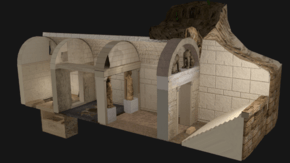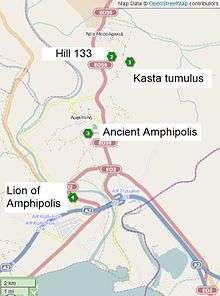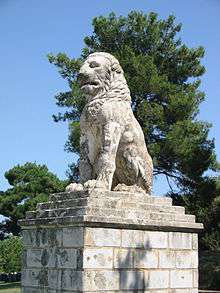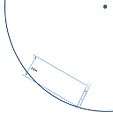Kasta Tomb
| Τύμβος Καστά[1] | |
 3D representation of the tomb structure | |
 Location within Greece | |
| Alternate name | Amphipolis Tomb (Τάφος της Αμφίπολης) |
|---|---|
| Location | Amphipolis |
| Region | Central Macedonia, Greece |
| Coordinates | 40°50′22.9″N 23°51′47.9″E / 40.839694°N 23.863306°ECoordinates: 40°50′22.9″N 23°51′47.9″E / 40.839694°N 23.863306°E |
| Type | Macedonian tomb |
| History | |
| Founded | Late 4th century BC[1] |
| Periods | Hellenistic |
| Associated with | Hephaestion |
| Site notes | |
| Excavation dates | 1964-present[2] |
| Archaeologists | Katerina Peristeri (Κατερίνα Περιστέρη) |
| Public access | Not accessible, excavations still under way |
The so-called Kasta Tomb, also known as the Amphipolis Tomb (Greek: Τάφος της Αμφίπολης), is an ancient Macedonian tomb that was discovered inside the Kasta mound (or Tumulus) near Amphipolis, Central Macedonia, in northern Greece in 2012 and first entered in August 2014.[2] The first excavations at the mound in 1964 led to exposure of the perimeter wall, and further excavations in the 1970s uncovered many other ancient remains.[3]
The recently discovered tomb is dated to the last quarter of the 4th century B.C. The tumulus is the largest ever discovered in Greece and by comparison dwarfs that of Philip II of Macedon, father of Alexander the Great, in Vergina.[2][4] The excavation team, based on findings unearthed at the site, argued that the tomb was a memorial dedicated to the close friend of Alexander the Great, Hephaestion.[5][6]
Identity
It is not yet known who is buried in the tomb, but the initial public speculation that it could be the tomb of Alexander the Great, because of its size and estimated cost of construction, was dismissed by the experts community when commenting on the published findings, as the available historical records mention Alexandria in Egypt as the last known location of Alexander's body; it has been supported instead, that a likely occupant could be either a wealthy Macedonian noble or a late member of the royal family.[2]
The skeletal remains of five people were unearthed within a corresponding tomb, in the lower levels of the third chamber in November 2014. The dead of the burial are: A woman at the age of 60, two men aged 35–45, a newborn infant and a fifth person represented by minimum fragments.[7] Further examination is underway with regard to the dating of the skeletal remains, as well as DNA cross examination between the dead of the burial as well as other skeletons from the neighboring tombs in the area.
At a press conference in the conference hall of the Aristotle University of Thessaloniki, Katerina Peristeri revealed the existence of three inscriptions apparently linking the tomb to Hephaestion, nobleman, General and close friend of Alexander the Great. The ancient Greek word "ΠΑΡΕΛΑΒΟΝ" (it means "received") is written in the inscriptions and next to it the monogram of Hephaestion.[5][6]
Discovery

In the 1970s a building of 10m width was found on top of the centre of the mound, and is thought to have been a grave marker. This, together with other evidence, supported the likelihood of a large funerary complex within. The tumulus was also found to have covered earlier cemeteries with at least 70 graves from the nearby "Hill 133" settlement predating Amphipolis.[3]
Finds
Archaeologists have made a number of important discoveries on the site since August 2014. Apart from the sheer size of the monument, which experts say bears the handprint of Dinocrates of Rhodes, the chief architect of Alexander the Great,[4] archaeologists have so far unearthed:
- Two marble sphinxes approximately 2 m (7 ft) tall that guard the main entrance to the tomb [1] (one head and wing fragments later found in third chamber).
- A fresco, paint still visible, that mimics an Ionian peristyle, on top of which the sphinxes sit[8][9]
- Two female statues of the Caryatid type in the antechamber, which support the entrance to the second compartment of the tomb[10] The height of each Caryatid is 2.27 m (7.4 ft).[11] The Caryatids are on a pedestal 1.40 m (4.6 ft) tall, making the total height of the statues 3.67 m (12.0 ft).[12]
- A marble door, typical of Macedonian tomb doors, broken into pieces in front of the doorway to the third chamber[13]
- A mosaic—3 m (9.8 ft) wide and 4.5 m (15 ft) long—in the third chamber, which seems to depict Persephone abducted by the god Pluto (Greek: Πλούτων, Ploutōn), ruler of the underworld, wearing a laurel wreath and driving a chariot drawn by horses led by the god Hermes, the conductor of souls to the afterlife.[14][15] The depiction of the abduction of Persephone in the mosaic floor implies links with the cluster of royal tombs in Vergina (Aigai), as a mural representing the same scene decorates one of the tombs where King Philip II, Alexander the Great's father, is buried.[16]
- The head of the eastern sphinx in the third and last chamber[17][18]
- Fragments of the wings of the sphinxes in the third chamber[19]
- An eight square metre vault and a marble door in the third chamber[20]
- Seven architraves were found in the 2nd Chamber, and restoration is under development.[21]
Burials
The skeletal remains of 5 individuals were found:
- a woman over 60 years of age
- two adult men, an elder and younger, between 35–45 years of age
- a newborn infant
- fragments of a cremated adult
The younger male showed signs of unhealed, possibly fatal wounds. Analysis of the skeletal remains is ongoing.[22]
Precautions
In response to the magnitude of the finds, the authorities of Central Macedonia have requested and were granted a heavy 24-hour police guard of the dig site, and have also begun procedures to have the Kasta Tomb included in UNESCO's list of World Heritage Sites as a "top priority."[23]

Gallery
 Excavation at the tomb of Amphipolis
Excavation at the tomb of Amphipolis The mosaic of the third chamber, representing the Abduction of Persephone by Pluto (Greek: Πλούτων, Ploutōn)
The mosaic of the third chamber, representing the Abduction of Persephone by Pluto (Greek: Πλούτων, Ploutōn) The Lion of Amphipolis, an 8 meters tall statue dated from the same period. Despite a theory that the lion was originally located on the top of the tomb, this has been dismissed by the excavation team.
The Lion of Amphipolis, an 8 meters tall statue dated from the same period. Despite a theory that the lion was originally located on the top of the tomb, this has been dismissed by the excavation team. The imposing size of the lion in an early picture of a plaster cast used for restoration of the original
The imposing size of the lion in an early picture of a plaster cast used for restoration of the original Kasta tumulus in Amphipolis, Macedonia. The tomb is also shown in scale. Tomb position is only indicative
Kasta tumulus in Amphipolis, Macedonia. The tomb is also shown in scale. Tomb position is only indicative Kasta tomb scaled to tumulus
Kasta tomb scaled to tumulus Illustration of Caryatids based on the findings
Illustration of Caryatids based on the findings The head of the excavations, Katerina Peristeri, during the official presentation of the findings.
The head of the excavations, Katerina Peristeri, during the official presentation of the findings.
In popular culture
The board game Amphipolis, designed by Reiner Knizia, was published in 2015 and it is based on the location and findings of the Kasta Tomb.[24][25]
References
- 1 2 3 "Συνέχιση ανασκαφικών εργασιών στον Τύμβο Καστά στην Αμφίπολη". www.yppo.gr. Ministry of Culture and Sport. 20 August 2014. Retrieved 10 September 2014.
- 1 2 3 4 Andrew Marszal (7 September 2014). "Marble female figurines unearthed in vast Alexander the Great-era Greek tomb". www.telegraph.co.uk. The Daily Telegraph. Retrieved 10 September 2014.
- 1 2 "Amphipolis", Ministry of Culture: ISBN 960-214-126-3
- 1 2 Kate Müser (9 September 2014). "Greece's largest ancient tomb: Amphipolis". www.dw.de. Deutsche Welle. Retrieved 10 September 2014.
- 1 2 http://www.usnews.com/news/world/articles/2015/09/30/excavator-ancient-grave-in-greece-honored-alexanders-pal
- 1 2 http://greece.greekreporter.com/2015/09/30/hephaestions-monogram-found-at-amphipolis-tomb/
- ↑ http://www.huffingtonpost.gr/2015/01/19/culture-nees-apokalipseis-gia-tin-amphipoli-_n_6495220.html. Missing or empty
|title=(help) - ↑ "Συνέχιση ανασκαφικών εργασιών στον Τύμβο Καστά στην Αμφίπολη". www.yppo.gr. Ministry of Culture and Sport. 21 August 2014. Retrieved 10 September 2014.
- ↑ "Συνέχιση ανασκαφικών εργασιών στην Αμφίπολη". www.yppo.gr. Ministry of Culture and Sport. 24 August 2014. Retrieved 10 September 2014.
- ↑ "Συνέχιση ανασκαφικών εργασιών στον Τύμβο Καστά στην Αμφίπολη". www.yppo.gr. Ministry of Culture and Sport. 7 September 2014. Retrieved 10 September 2014.
- ↑ "Συνέχιση ανασκαφικών εργασιών στον Τύμβο Καστά στην Αμφίπολη". www.yppo.gr. Ministry of Culture and Sport. 21 September 2014. Retrieved 12 October 2014.
- ↑ "Συνέχιση ανασκαφικών εργασιών στον Τύμβο Καστά στην Αμφίπολη". www.yppo.gr. Ministry of Culture and Sport. 21 September 2014. Retrieved 30 September 2014.
- ↑ "Συνέχιση ανασκαφικών εργασιών στον Τύμβο Καστά στην Αμφίπολη". www.yppo.gr. Ministry of Culture and Sport. 2 October 2014. Retrieved 13 October 2014.
- ↑ "Greece archaeologists uncover Amphipolis floor mosaic". www.bbc.com. BBC. 12 October 2014. Retrieved 12 October 2014.
- ↑ "Amphipolis tomb: Archeologists reveal figure of Persephone in mosaic - The discovery also suggests that the bearded man is the god Pluto, ruler of the underworld". www.tovima.gr. TO BHMA. 16 October 2014. Retrieved 17 October 2014.
- ↑ http://archaeologynewsnetwork.blogspot.co.uk/2014/10/amphipolis-mosaic-portrays-abduction-of.html#.Vayr_M6ARBw
- ↑ "One of the sphinxes' heads found at Kasta". www.newstomb.gr. newstomb. 22 October 2014. Retrieved 24 October 2014.
- ↑ livescience: Missing Sphinx Head Found in Ancient Greek Tomb, October 22, 2014
- ↑ "Amphipolis: Sphinxes's wings discovered; Video from inside the tomb released". www.keeptalkinggreece.com. Keep Talking Greece. 28 October 2014. Retrieved 28 October 2014.
- ↑ "Eight Square Meter Vault and Marble Door Found in Amphipolis Tomb". greece.greekreporter.com. Greek Reporter. 31 October 2014. Retrieved 31 October 2014.
- ↑ "Seven architraves were found in the 2nd Chamber". https://www.facebook.com/amphipolis.tomb.discovery. https://www.facebook.com/amphipolis.tomb.discovery. 31 October 2014. Retrieved 31 October 2014. External link in
|website=, |publisher=(help) - ↑ Hellenic Republic, Ministry of Culture and Sports, January 19, 2015 Press Release (in Greek)
- ↑ "Αμφίπολη: Προς ένταξη στα μνημεία της UNESCO – Εντυπωσιακό βίντεο από ελικόπτερο". www.euronews.com. Euronews. 3 September 2014. Retrieved 10 September 2014.
- ↑ "Amphipolis | Board Game | The Dice Tower | The Dice Tower". www.dicetower.com. Retrieved 2016-03-24.
- ↑ "Who will save Amphipolis?, Sakis Ioannidis | Kathimerini". www.ekathimerini.com. Retrieved 2016-03-24.
External links
- Official site about history of Amphipolis
- ANCIENT AMPHIPOLIS AND THE GREAT TOMB
- Video from inside the tomb, provided by the Ministry of Culture and Sports, Greece, 28/10/2014
- Interactive version of the 3D model
- Photographic material of the findings
- A representation of a restored version of the mosaic
- A virtual tour of the monument
- Up to date information on Amphipolis tomb
-
 Media related to Kasta tumulus at Wikimedia Commons
Media related to Kasta tumulus at Wikimedia Commons - Missing Sphinx Head Found in Ancient Greek Tomb By Megan Gannon, livescience, October 22, 2014
- Hellenic Republic, Ministry of Culture and Sports, January 19, 2015 Press Release (in Greek)
